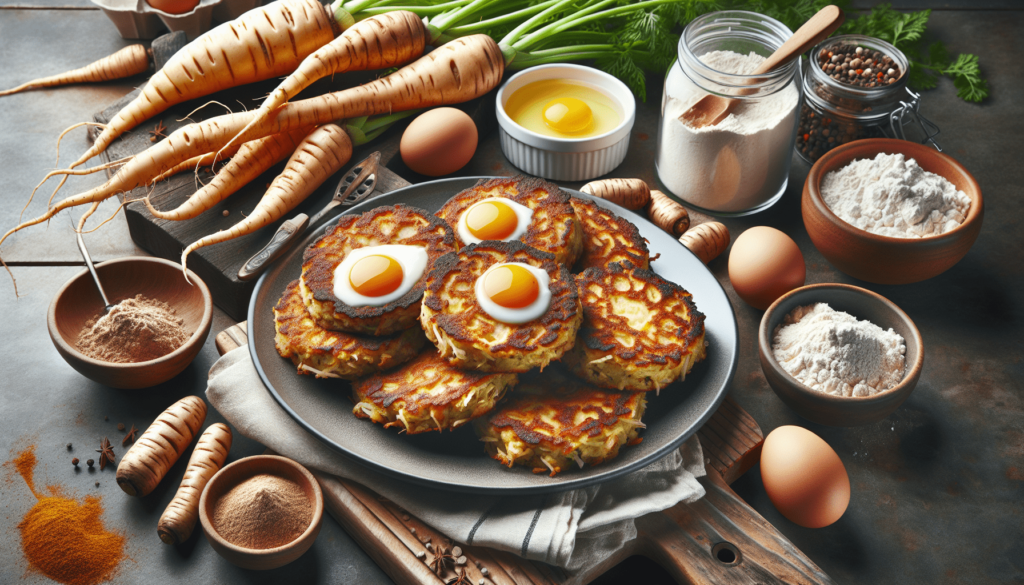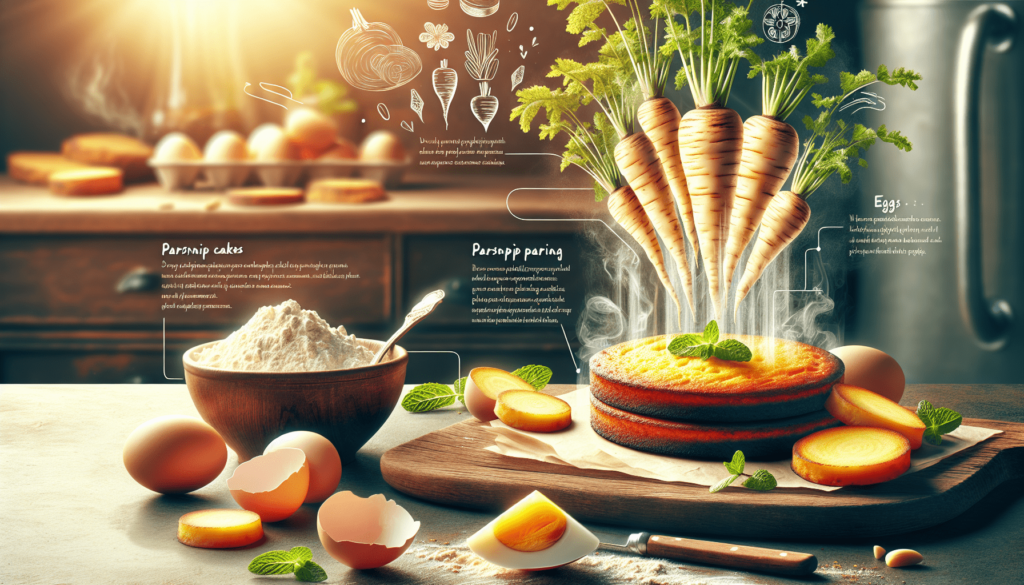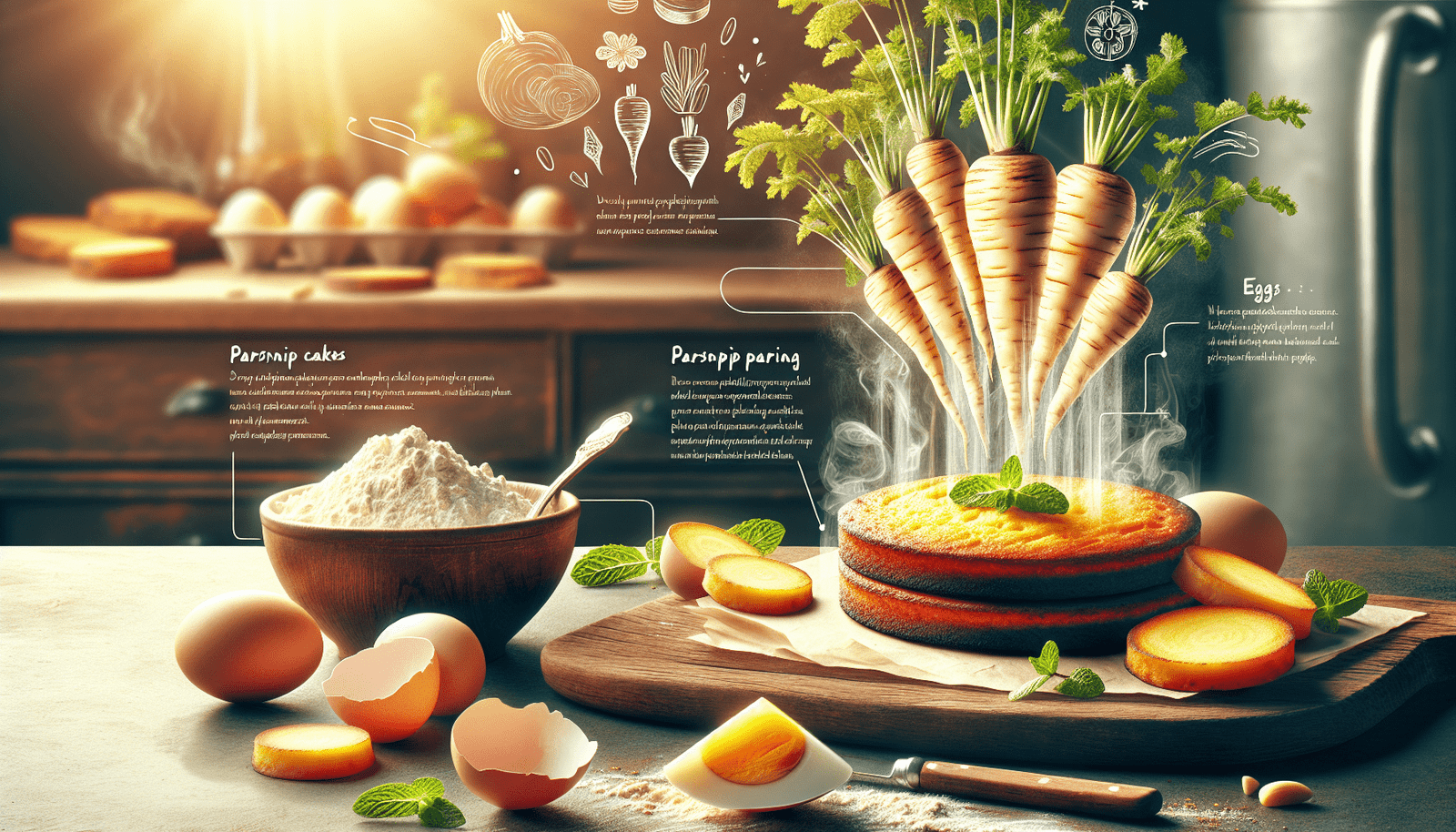Are you ready to indulge in a delicious and unique treat? Look no further than the Parsnip Cakes Recipe! This delightful dish combines the earthy sweetness of parsnips with a crispy exterior, leaving your taste buds begging for more. Whether you’re a seasoned chef or just starting out in the kitchen, this recipe is sure to impress. So grab your apron and get ready to elevate your culinary skills to new heights with these delectable parsnip cakes!
Ingredients
To make parsnip cakes, you will need the following ingredients:
Parsnips
Parsnips are the star ingredient of this recipe. They have a slightly sweet and nutty flavor.
Eggs
Eggs are used to bind the parsnip mixture together and provide structure to the cakes.
Flour
Flour is added to the batter to give the parsnip cakes the right consistency and texture.
Baking powder
Baking powder helps the parsnip cakes become light and fluffy.
Salt
Salt enhances the flavor of the parsnip cakes and brings out the natural sweetness of the parsnips.
Black pepper
Black pepper adds a subtle kick and complements the earthy flavor of the parsnips.
Chives
Chives provide a fresh and mild onion flavor to the parsnip cakes.
Vegetable oil
Vegetable oil is used for frying the parsnip cakes to achieve a crispy exterior.
Preparation
To prepare the parsnip cakes, follow these steps:
Peel and grate the parsnips
Start by peeling the parsnips and then grate them using a box grater or a food processor.
Squeeze out excess moisture from grated parsnips
Place the grated parsnips in a clean towel or cheesecloth and squeeze out any excess moisture. This will prevent the parsnip cakes from being too wet.
Beat eggs in a mixing bowl
In a mixing bowl, beat the eggs until they are well combined.
Add grated parsnips to the beaten eggs
Add the grated parsnips to the beaten eggs and mix well to ensure they are evenly coated.
In a separate bowl, mix flour, baking powder, salt, and black pepper
In a separate bowl, combine the flour, baking powder, salt, and black pepper. Mix them together until well combined.
Combine the dry ingredients with the parsnip mixture
Gradually add the dry ingredients to the parsnip and egg mixture, stirring until just combined. Be careful not to overmix.
Add chopped chives to the batter
Add the chopped chives to the batter and gently fold them in.
Heat vegetable oil in a skillet
Heat vegetable oil in a skillet over medium heat. Make sure the oil is hot before adding the parsnip batter.
Spoon the batter onto the skillet
Using a spoon, carefully drop spoonfuls of the parsnip batter onto the hot skillet. Flatten them slightly with the back of the spoon.
Cook the parsnip cakes until golden brown on each side
Cook the parsnip cakes for about 3-4 minutes on each side or until they are golden brown and crispy. Flip them carefully to ensure they don’t break apart.

Variations
Parsnip cakes can be customized with different variations to suit your taste preferences. Here are a few ideas:
Sweet parsnip cakes with cinnamon and nutmeg
For a sweeter twist, add a teaspoon of cinnamon and a pinch of nutmeg to the batter. This will give the parsnip cakes a warm and cozy flavor.
Spicy parsnip cakes with paprika and cayenne pepper
To add some heat, sprinkle some paprika and cayenne pepper into the batter. This variation is perfect for those who enjoy a kick in their dishes.
Cheesy parsnip cakes with grated cheddar
For a cheesy delight, mix in some grated cheddar cheese into the parsnip batter. The melted cheese will add a savory and gooey touch to the cakes.
Serving Suggestions
Parsnip cakes can be served in various ways to complement different meals. Here are some serving suggestions:
Serve parsnip cakes as a side dish with roast chicken
Parsnip cakes make a delightful side dish when served alongside roast chicken. The crispy exterior and soft interior of the cakes perfectly complement the tender chicken.
Top parsnip cakes with sour cream or Greek yogurt
For a creamy touch, top your parsnip cakes with a dollop of sour cream or Greek yogurt. The tangy and cool flavors will balance the earthiness of the parsnips.
Serve parsnip cakes with a fresh salad
Pair your parsnip cakes with a refreshing salad for a complete and nutritious meal. The crispness of the salad will provide a lovely contrast to the softness of the cakes.

Storage
If you have leftovers or want to make the parsnip cakes ahead of time, here’s how to store them:
Allow parsnip cakes to cool completely
Before storing the parsnip cakes, make sure they are cooled down to room temperature.
Place in an airtight container
Transfer the cooled parsnip cakes to an airtight container. This will help keep them fresh and prevent them from drying out.
Refrigerate for up to 3 days
Store the container of parsnip cakes in the refrigerator. They can be kept for up to 3 days.
Reheat in a skillet or microwave before serving
When you’re ready to enjoy the leftover parsnip cakes, simply reheat them in a skillet over medium heat or in the microwave until heated through. This will restore their crispiness.
Tips and Tricks
Here are some tips and tricks to ensure your parsnip cakes turn out perfect:
Use a food processor to grate parsnips quickly
If you’re short on time, using a food processor to grate the parsnips can save you a lot of effort.
Ensure the skillet is hot before adding the batter
To achieve a crispy exterior, make sure the skillet is heated properly before adding the parsnip batter.
Flip the parsnip cakes carefully to avoid breaking
When flipping the parsnip cakes, use a spatula and be gentle to avoid any breaking or crumbling.
Adjust the seasoning to your taste preferences
Feel free to adjust the seasoning in the parsnip cake batter to suit your personal taste. You can add more salt, pepper, or any other preferred spices.
Health Benefits
Parsnip cakes offer several health benefits due to their main ingredient, parsnips. Here are some notable health benefits:
Parsnips are a good source of fiber
Fiber is essential for good digestion and can help promote a healthy gut. Parsnips are rich in dietary fiber, which can aid in maintaining regular bowel movements.
Contain essential vitamins and minerals
Parsnips are packed with vitamins and minerals, including vitamin C, vitamin K, potassium, and manganese. These nutrients are important for supporting overall health.
Low in calories
If you’re watching your calorie intake, parsnip cakes are a great option. They are relatively low in calories, making them a healthier alternative to heavier side dishes.
Can aid digestion
Due to their high fiber content, parsnips can help promote healthy digestion and prevent constipation. Including parsnips in your diet can contribute to better digestive health.
History of Parsnip Cakes
Parsnips have a long history and have been cultivated for centuries. They have been a popular ingredient in European cuisine, particularly in countries like England, France, and Ireland. Parsnip cakes are believed to have originated from these regions, where they were traditionally served during holidays and celebrations. Over time, parsnip cakes have gained popularity as a versatile and delicious dish enjoyed by many.
FAQs
Here are answers to some frequently asked questions about parsnip cakes:
Can I freeze parsnip cakes?
Yes, you can freeze parsnip cakes. Once cooled, place them in an airtight container or freezer bags and store them in the freezer for up to 3 months. Thaw them in the refrigerator overnight before reheating.
Can I use other vegetables instead of parsnips?
While parsnips are the traditional vegetable used in parsnip cakes, you can certainly experiment with other root vegetables like carrots or sweet potatoes. However, keep in mind that the flavor and texture of the cakes may vary.
Can I make parsnip cakes gluten-free?
Yes, you can make gluten-free parsnip cakes by using gluten-free flour instead of regular flour. There are various gluten-free flour options available, such as almond flour or rice flour.
How can I make the batter vegan?
To make the parsnip cake batter vegan, you can substitute the eggs with a flaxseed or chia seed egg replacement. Simply mix 1 tablespoon of ground flaxseed or chia seeds with 3 tablespoons of water, let it sit for a few minutes until it thickens, and then use it as a replacement for each egg.
Are parsnip cakes suitable for children?
Parsnip cakes can be a nutritious and tasty option for children. They can be served as a healthy snack or a side dish with their favorite protein. Just be mindful of any allergies or dietary restrictions they may have.
Conclusion
In conclusion, parsnip cakes are a delicious and versatile dish that can be enjoyed in various ways. Whether you prefer them plain or with different flavor variations, parsnip cakes are easy to make and sure to please your taste buds. They can be served as a side dish, topped with sour cream or Greek yogurt, or paired with a fresh salad. With their health benefits and rich history, parsnip cakes are a wonderful way to savor the unique flavor of parsnips. So gather your ingredients, follow the simple preparation steps, and enjoy the goodness of parsnip cakes!


